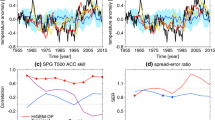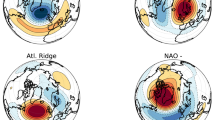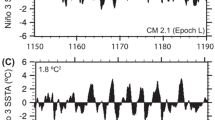Abstract
The Atlantic subpolar gyre (SPG) is one of the main drivers of decadal climate variability in the North Atlantic. Here we analyze its dynamics in pre-industrial control simulations of 19 different comprehensive coupled climate models. The analysis is based on a recently proposed description of the SPG dynamics that found the circulation to be potentially bistable due to a positive feedback mechanism including salt transport and enhanced deep convection in the SPG center. We employ a statistical method to identify multiple equilibria in time series that are subject to strong noise and analyze composite fields to assess whether the bistability results from the hypothesized feedback mechanism. Because noise dominates the time series in most models, multiple circulation modes can unambiguously be detected in only six models. Four of these six models confirm that the intensification is caused by the positive feedback mechanism.











Similar content being viewed by others
References
Bacon S (1997) Circulation and fluxes in the North Atlantic between Greenland and Ireland. J Phys Oceanogr 27:1420–1435
Böning C, Scheinert M, Dengg J, Biastoch A, Funk A (2006) Decadal variability of subpolar gyre transport and its reverberation in the North Atlantic overturning. Geophys Res Lett 33:L21S01
Born A, Kageyama M, Nisancioglu KH (2010a) Warm Nordic Seas delayed glacial inception in Scandinavia. Clim Past 6:817–826
Born A, Levermann A (2010) The 8.2 ka event: Abrupt transition of the subpolar gyre toward a modern North Atlantic circulation. Geochem Geophys Geosyst 11:Q06011
Born A, Mignot J (2011) Dynamics of decadal variability in the Atlantic subpolar gyre: a stochastically forced oscillator. Clim Dyn. 39:461–474
Born A, Nisancioglu KH, Braconnot P (2010b) Sea ice induced changes in ocean circulation during the Eemian. Clim Dyn 35(7):1361
Born A, Nisancioglu KH, Risebrobakken B (2011) Late Eemian warming in the Nordic Seas as seen in proxy data and climate models. Paleoceanography 26:PA2207
Clarke RA (1984) Transport through the cape farewell-flemish cap section. Rapp PV Reun Cons Int Explor Mer 185:120–130
Curry R, McCartney M, Joyce T (1998) Oceanic transport of subpolar climate signals to mid-depth subtropical waters. Nature 391:575–577
Danabasoglu G, Bates S, Briegleb BP, Jayne SR, Jochum M, Large WG, Peacock S, Yeager SG (2012) The CCSM4 Ocean component. J Clim 25:1361–1389
Danabasoglu G, Large WG, Briegleb BP (2010) Climate impacts of parameterized Nordic Sea overflows. J Geophys Res 115:C11005
Delworth TL, Manabe S, Stouffer RJ (1993) Interdecadal variations of the thermohaline circulation in a coupled Ocean-atmosphere model. J Clim 6:1993–2011
Deshayes J, Straneo F, Spall MA (2009) Mechanisms of variability in a convective basin. J Mar Res 67(3):273–303
Diansky NA, Volodin EM (2002) Simulation of present-day climate with a coupled Atmosphere-ocean general circulation model. Izv Atmos Ocean Phys (Engl Transl) 38(6):732–747
Ditlevsen PD (1999) Observation of α-stable noise induced millennial climate changes from an ice-core record. Geophys Res Lett 26(10):1441–1444
Eden C, Jung T (2001) North Atlantic interdecadal variability: Oceanic response to the North Atlantic oscillation (1865–1997). J Clim 14:676–691
Eden C, Willebrand J (2001) Mechanism of interannual to decadal variability of the North Atlantic circulation. J Clim 14:2266–2280
Furevik T, Bentsen M, Drange H, Kindem IKT, Kvamstø NG, Sorteberg A (2003) Description and evaluation of the bergen climate model: ARPEGE coupled with MICOM. Clim Dyn 21(1):27–51
Gardiner CW (1985) Handbook of stochastic methods. Springer, Berlin, Heidelberg, New York
Gent PR, Danabasoglu G, Donner L, Holland M, Hunke E, Jayne S, Lawrence D, Neale R, Rasch P, Vertenstein M, Worley P, Yang Z-L, Zhang M (2011) The community climate system model version 4. J Clim 24:4973–4991
Gordon C, Cooper C, Senior CA, Banks HT, Gregory JM, Johns TC, Mitchell JFB, Wood RA (2000) The simulation of SST, sea ice extents and ocean heat transports in a version of the Hadley Centre coupled model without flux adjustments. Clim Dyn 16:147–168
Gordon HB, Rotstayn LD, McGregor JL, Dix MR, Kowalczyk EA, O’Farrell SP, Waterman LJ, Hirst AC, Wilson SG, Collier, MA, Watterson IG, Elliott TI (2002) The CSIRO Mk3 Climate system model. Technical report, Aspendale: CSIRO Atmospheric Research. (CSIRO Atmospheric Research technical paper; no. 60)
Greatbatch RJ, Fanning AF, Goulding AD, Levitus S (1991) A diagnosis of interpentadal circulation changes in the North Atlantic. J Geophys Res 96:22,009–22,023
Häkkinen S, Rhines PB (2009) Shifting surface currents in the northern North Atlantic Ocean. J Geophys Res 114:C04005
Häkkinen S, Rhines PB, Worthen DL (2011) Atmospheric blocking and Atlantic Multidecadal Ocean variability. Science 334:655–659
Hátún H, Sandø AB, Drange H, Hansen B, Valdimarsson H (2005) Influence of the Atlantic subpolar gyre on the thermohaline circulation. Science 309:1841–1844
Holliday NP, Hughes SL, Bacon S, Beszczynska-Möller A, Hansen B, Lavín A, Loeng H, Mork KA, Østerhus S, Sherwin T, Walczowski W (2008) Reversal of the 1960s to 1990s freshening trend in the northeast North Atlantic and Nordic Seas. Geophys Res Lett 35:L03614
Iovino D, Straneo F, Spall M (2008) The effect of a sill on dense water formation in a marginal sea. J Mar Res 66:325–345
Jungclaus JH, Keenlyside N, Botzet M, Haak H, Luo J-J, Latif M, Marotzke J, Mikolajewicz U, Roeckner E (2006) Ocean circulation and tropical variability in the coupled model ECHAM5/MPI-OM. J Clim 19:3952–3972
Knight JR, Folland CK, Scaife AA (2006) Climate impacts of the Atlantic multidecadal oscillation. Geophys Res Lett 33:L17706
Kwasniok F, Lohmann G (2009) Deriving dynamical models from paleoclimatic records: application to glacial millennial-scale climate variability. Phys Rev E 80:066104
Legutke S, Voss R (1999) ECHO-G, the Hamburg atmosphere-ocean coupled circulation model. Technical report, DKRZ technical report 18, DKRZ, Hamburg
Levermann A, Born A (2007) Bistability of the Atlantic subpolar gyre in a coarse-resolution model. Geophys Res Lett 34:L24605
Lilly JM, Rhines PB, Visbeck M, Davis R, Lazier JRN, Schott F, Farmer D (1999) Observing deep convection in the labrador sea during winter 1994/95. J Phys Oceanogr 29:2065–2098
Livina VN, Ditlevsen P, Lenton TM (2012) An independent test of methods of detecting system states and bifurcations in time-series data. Phys A 391:485–496
Livina VN, Kwasniok F, Lenton TM (2010) Potential analysis reveals changing number of climate states during the last 60 kyr. Clim Past 6:77–82
Livina VN, Kwasniok F, Lohmann G, Kantelhardt JW, Lenton TM (2011) Changing climate states and stability: from Pliocene to present. Clim Dyn 37:2437–2453
Lohmann K, Drange H, Bentsen M (2009) Response of the North Atlantic subpolar gyre to persistent North Atlantic oscillation like forcing. Clim Dyn 32:273–285
Mann ME, Zhang Z, Rutherford S, Bradley RS, Hughes MK, Shindell D, Ammann C, Faluvegi G, Ni F (2009) Global signatures and dynamical origins of the little ice age and medieval climate anomaly. Science 326:1256–1260
Marti O, Braconnot P, Dufresne J-L, Bellier J, Benshila R, Bony S, Brockmann P, Cadule P, Caubel A, Codron F, de Noblet N, Denvil S, Fairhead L, Fichefet T, Foujols M-A, Friedlingstein P, Goosse H, Grandpeix J-Y, Guilyardi E, Hourdin F, Idelkadi A, Kageyama M, Krinner G, Lévy C, Madec G, Mignot J, Musat I, Swingedouw D, Talandier C (2010) Key features of the IPSL ocean atmosphere model and its sensitivity to atmospheric resolution. Clim Dyn 34:1–26
McFarlane NA, Scinocca JF, Lazare M, Harvey R, Verseghy D, Li J (2011). The CCCma third generation atmospheric general circulation model. Technical report, CCCma internal report
Mellor G, Mechoso C, Keto E (1982) A diagnostic calculation of the general circulation of the Atlantic Ocean. Deep Sea Res 29:1171–1192
Mengel M, Levermann A, Schleussner C, Born A (2012) Enhanced subpolar-gyre variability through baroclinic threshold in the Atlantic. Earth Syst Dyn Discuss 3. doi:10.5194/esdd-3-259-2012
Montoya M, Born A, Levermann A (2011) Reversed North Atlantic gyre dynamics in glacial climate. Clim Dyn 36(5–6):1107–1118
Myers PG, Fanning AF, Weaver AJ (1996) JEBAR, bottom pressure torque, and Gulf stream separation. J Phys Ocean 26:671–683
Penduff T, Barnier B, de Verdière AC (2000) Self-adapting open boundaries for a sigma coordinate model of the eastern North Atlantic. J Geophys Res 105:11,279–11,298
Prater MD (2002) Eddies in the labrador sea as observed by profiling RAFOS floats and remote sensing. J Phys Oceanogr 32:411–427
Reid JL (1994) On the total geostrophic circulation of the North Atlantic Ocean: flow patterns, tracers, and transports. Prog Oceanogr 33:1–92
Renold M, Raible CC, Yoshimori M, Stocker TF (2010) Simulated resumption of the North Atlantic meridional overturning circulation—slow basin-wide advection and abrupt local convection. Quatern Sci Rev 29:101–112
Salas-Mélia D, Chauvin F, Déqué M, Douville H, Gueremy JF, Marquet P, Planton S, Royer JF, Tyteca S (2005) Description and validation of the CNRM-CM3 global coupled model. Technical report
Schlesinger ME, Ramankutty N (1994) An oscillation in the global climate system of period 65–70 years. Nature 367:723–726
Schmidt GA, Ruedy R, Hansen JE, Aleinov I, Bell N, Bauer M, Bauer S, Cairns B, Canuto V, Cheng Y, Genio AD, Faluvegi G, Friend AD, Hall TM, Hu Y, Kelley M, Kiang NY, Koch D, Lacis AA, Lerner J, Lo KK, Miller RL, Nazarenko L, Oinas V, Perlwitz JP, Rind D, Romanou A, Russell GL, Sato M, Shindell DT, Stone PH, Sun S, Tausnev N, Thresher D, Yao M-S (2006) Present day atmospheric simulations using GISS ModelE: comparison to in-situ, satellite and reanalysis data. J Clim 19:153–192
Spall MA (2004) Boundary currents and watermass transformation in marginal seas. J Phys Oceanogr 34:1197–1213
Spall MA (2008) Low-frequency interaction between horizontal and overturning gyres in the ocean. Geophys Res Lett 35:L18614
Straneo F (2006a) Heat and freshwater transport through the central labrador sea. J Phys Oceanogr 36:606–628
Straneo F (2006b) On the connection between dense water formation, overturning, and poleward heat transport in a convective basin. J Phys Oceanogr 36:1822–1840
Swingedouw D, Braconnot P, Delecluse P, Guilyardi E, Marti O (2007) The impact of global freshwater forcing on the thermohaline circulation: adjustment of North Atlantic convection sites in a CGCM. Clim Dyn 28:291–305
Thornalley DJR, Elderfield H, McCave IN (2009) Holocene oscillations in temperature and salinity of the surface North Atlantic. Nature 457:711–714
Treguier AM, Theetten S, Chassignet EP, Penduff T, Smith R, Talley L, Beismann JO, Böning C (2005) The North Atlantic subpolar gyre in four high-resolution models. J Phys Oceanogr 35:757–774
Yongqiang Y, Xuehong Z, Yufu G (2004) Global coupled ocean- atmosphere general circulation models in LASG/IAP. Adv Atmos Sci 21:444–455
Yoshimori M, Raible CC, Stocker TF, Renold M (2010) Simulated decadal oscillations of the Atlantic meridional overturning circulation in a cold climate state. Clim Dyn 34:101–121
Yukimoto S, Noda A, Kitoh A, Hosaka M, Yoshimura H, Uchiyama T, Shibata K, Arakawa O, Kusunoki S (2006) Present-day climate and climate sensitivity in the Meteorological Research Institute coupled GCM version 2.3 (MRI-CGCM2.3). J Meteor Soc Jpn 84:333–363
Acknowledgments
We acknowledge the modeling groups, the Program for Climate Model Diagnosis and Intercomparison (PCMDI) and the WCRP’s Working Group on Coupled Modelling (WGCM) for their roles in making available the WCRP CMIP3 multi-model dataset. Support of this dataset is provided by the Office of Science, U.S. Department of Energy. We are grateful to Dr. Johann Jungclaus and to Dr. Jonathan Gregory for providing data of MPI-ESM and HadCM3, respectively. Simulations with CCSM4 were carried out on the ’bluefire’ system of the Computational and Informations Systems Laboratory (CISL). Simulations with IPSL CM4 hires were funded by the EC-FP6 project ‘ENSEMBLES’. Additional compute time was provided by the Swiss National Supercomputing Centre (CSCS). A. B. is supported by the European Commission under the Marie Curie Intra-European Fellowship ECLIPS (PIEF-GA-2011-300544) and the ‘National Centre for Excellence in Research: Climate’ of the Swiss National Science Foundation.
Author information
Authors and Affiliations
Corresponding author
Rights and permissions
About this article
Cite this article
Born, A., Stocker, T.F., Raible, C.C. et al. Is the Atlantic subpolar gyre bistable in comprehensive coupled climate models?. Clim Dyn 40, 2993–3007 (2013). https://doi.org/10.1007/s00382-012-1525-7
Received:
Accepted:
Published:
Issue Date:
DOI: https://doi.org/10.1007/s00382-012-1525-7




